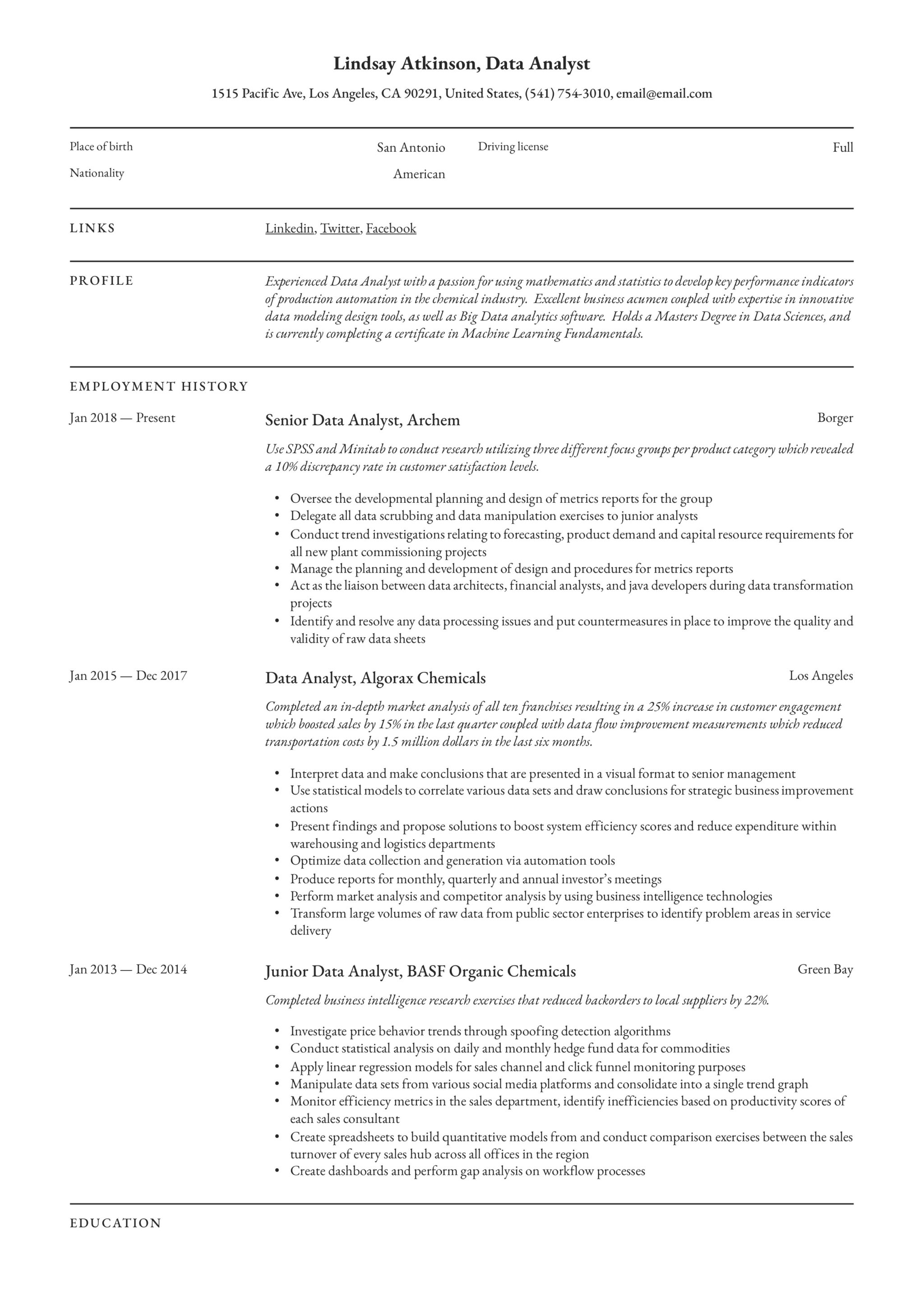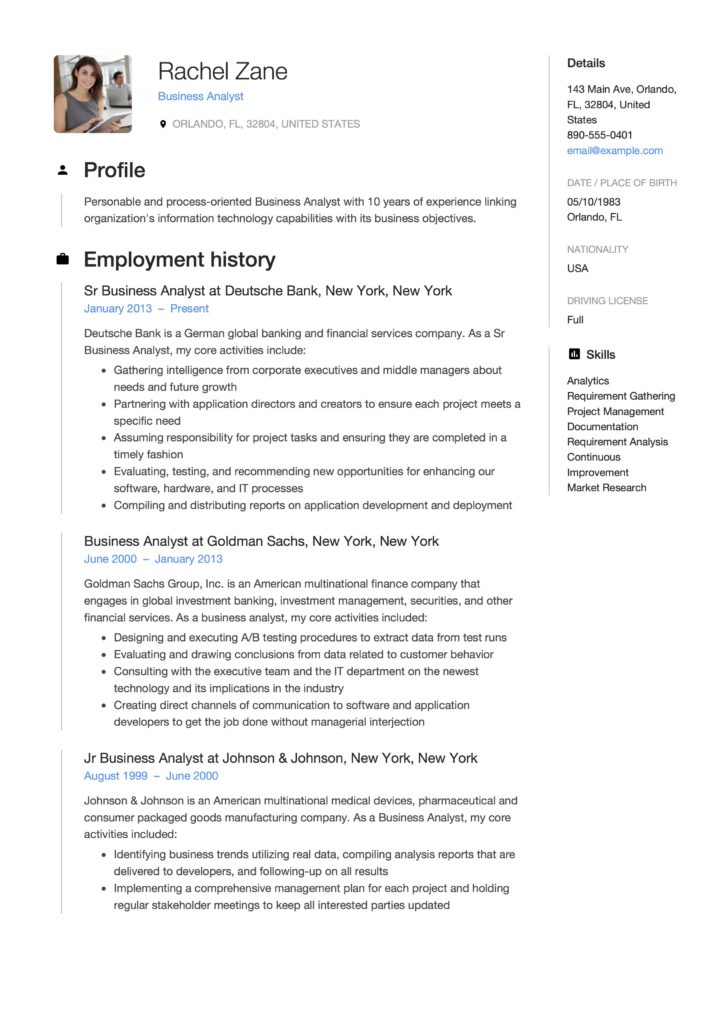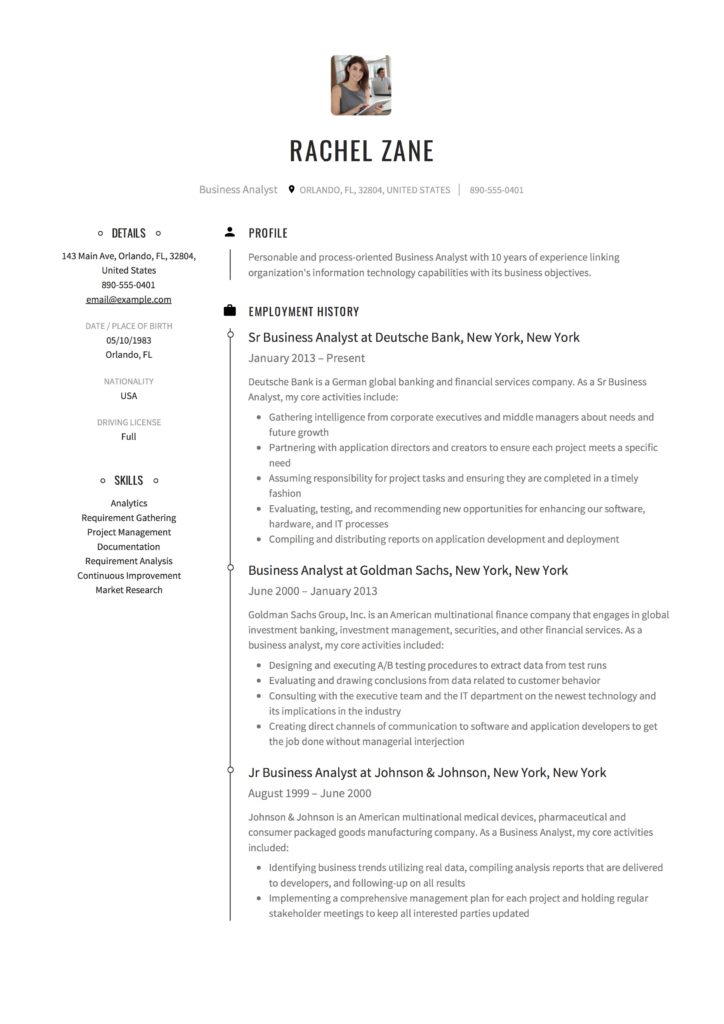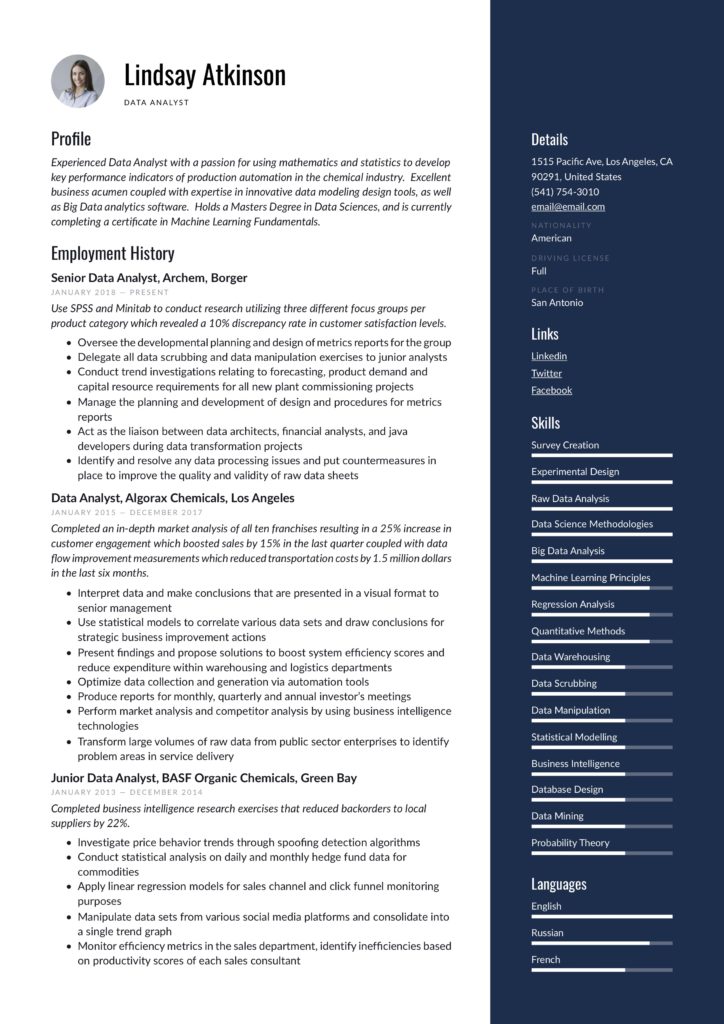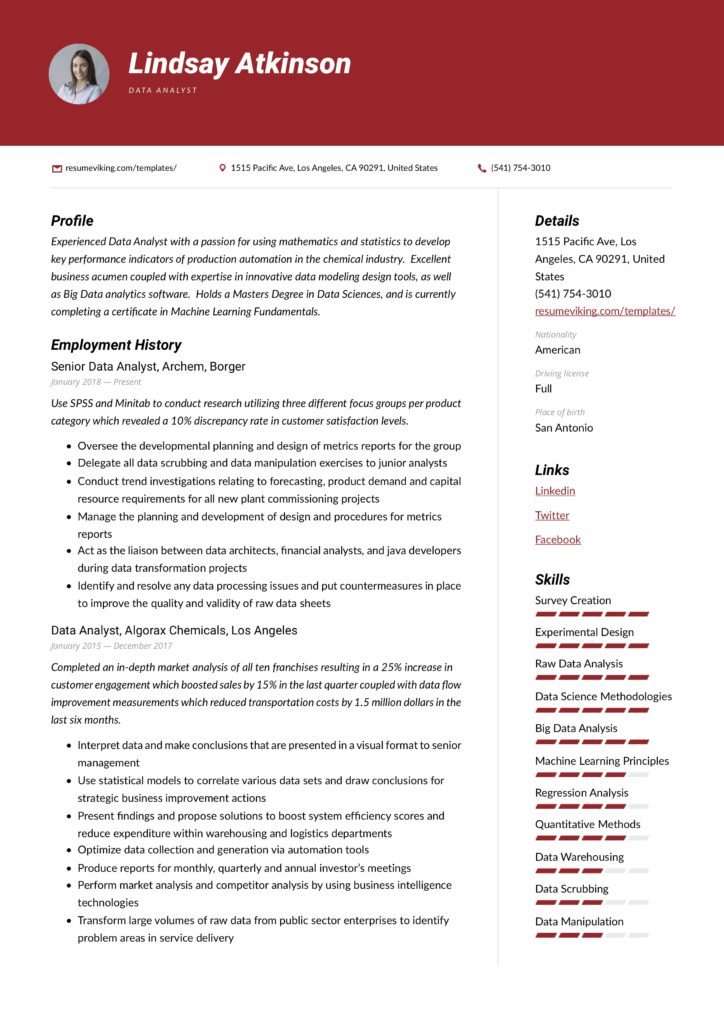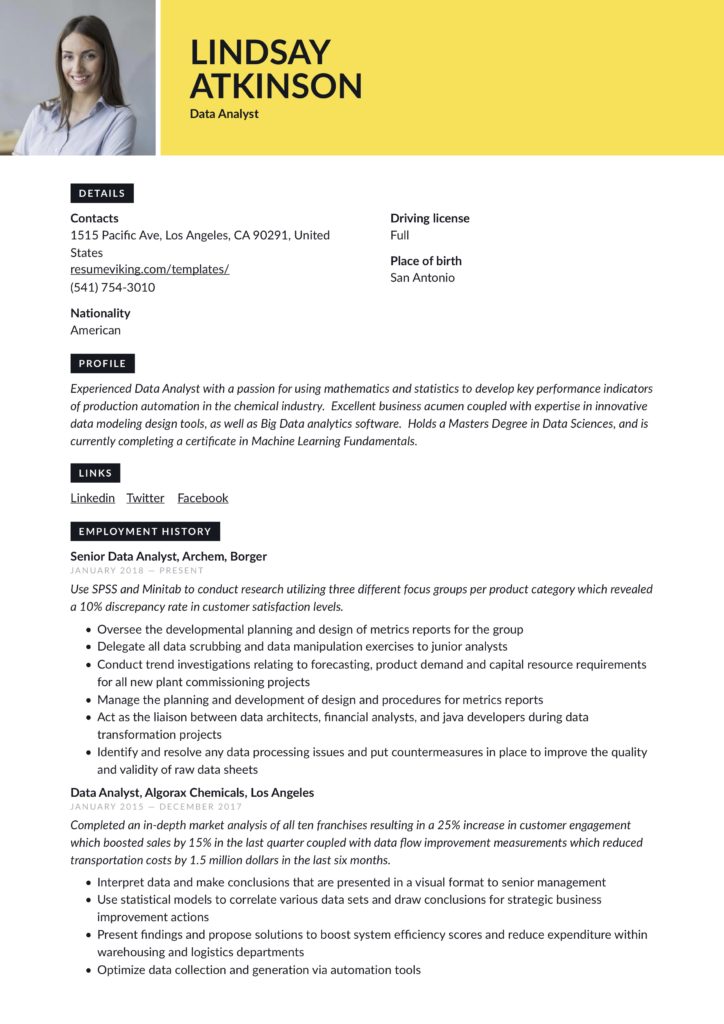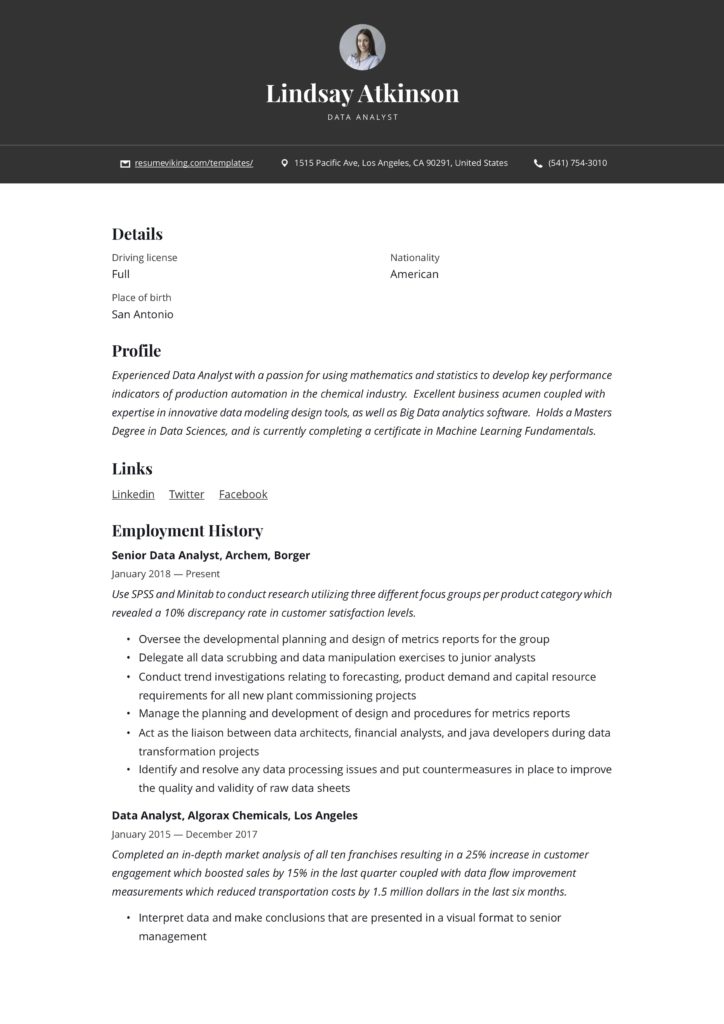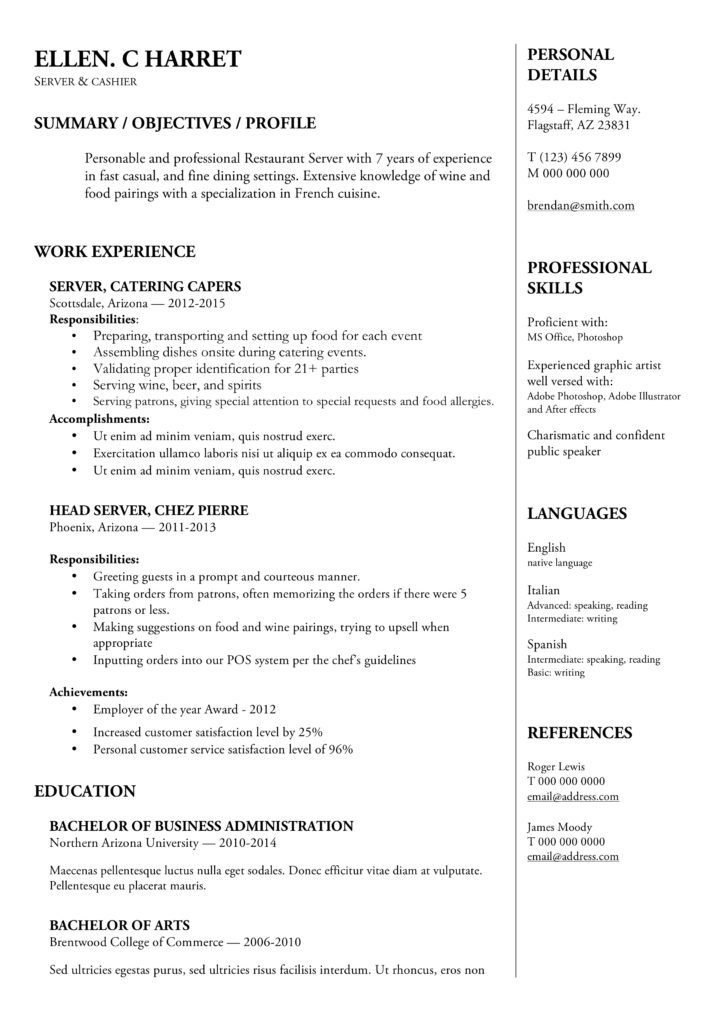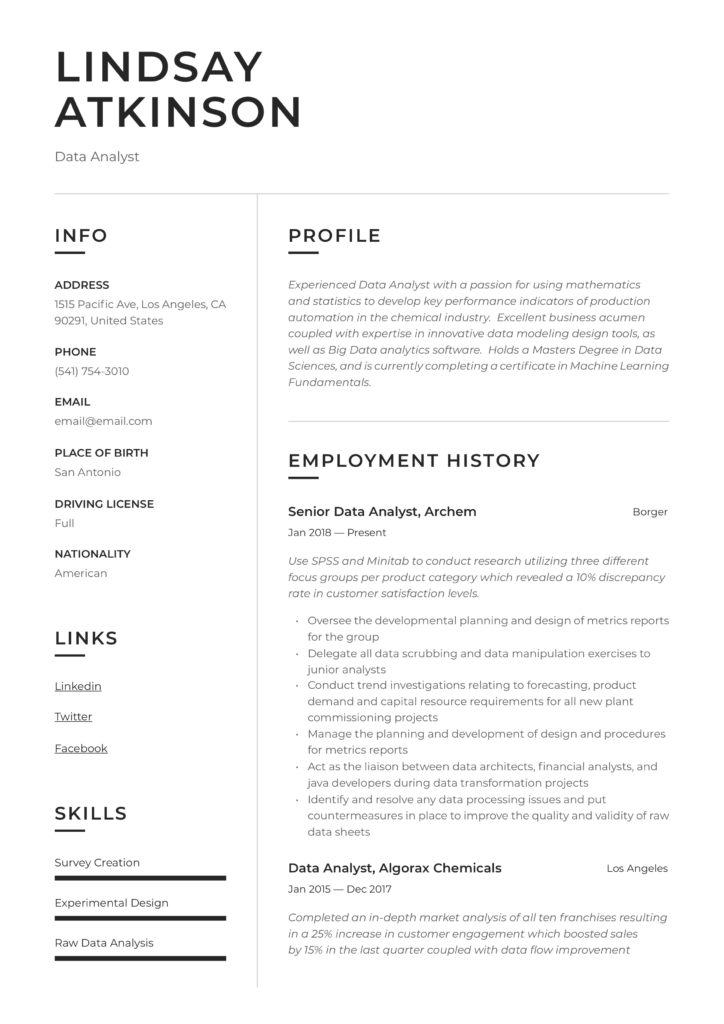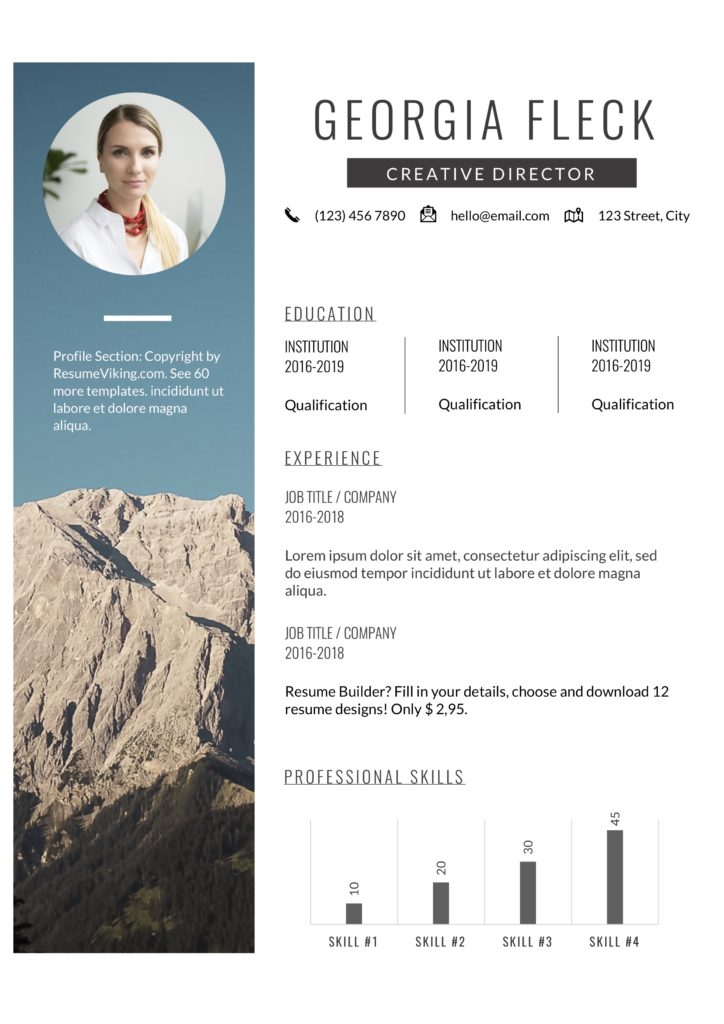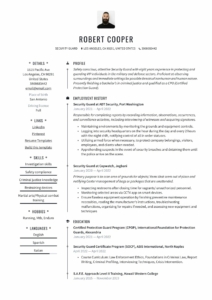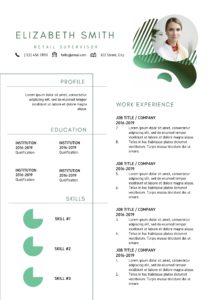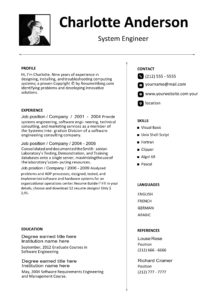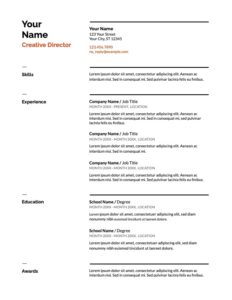Data is everywhere, and so are Data Analyst jobs. The growth spurt in data sciences is not plating down soon, in fact data sciences is the ‘’new accounting’’ of the Fourth Industrial Revolution.
Becoming part of this ever-growing information phenomenon? A Data Analyst Resume requires a lot that is on point and on par with the ever-evolving changes in this industry.
Our Data Analyst Resume Examples may assist you in creating a resume that will knock the socks off any recruiter or hiring manager reviewing your application.
Your passion may be all about data sets, algorithms, and correlations; our’s is the art of resume creation to land interviews.
How you create a resume into an interview-winning document, we will explain to you in detail below with our: Resume Guidelines for Data Analyst Roles.
What you can read in this article
19 Free Data Analyst Resume Templates
Download these templates at the bottom of this page for free. Freely edit and download all designs from one point? Start the resume builder!
Data Analyst Resume Writing Guide
Resume Sections
1. Contact Information
- Name
- Address
- Number
- LinkedIn Profile URL or similar to an alternative contact measure and profile.
2. Career Summary
Aim for a crisp, concise, and punchy summary without using personal pronouns or too many adjectives. Place the career summary at the top of your resume page and highlight it in a different font size and in bold.
The emphasis should be on technical skills, industry expertise and academic background all merged in a paragraph of 3-6 lines. (see below for samples)
3. Qualifications Summary
This is the one industry where you cannot skimp on qualifications. Degrees up to Ph.D. level with data analytics or data science as both majors and minors, are typical to this field.
Provide up to date information about the qualifications you have completed and the ones you are in process of completing by indicating institution, qualification name, and dates.
4. Relevant Data Analyst Experience:
Collecting, processing, and analyzing is the primary function of a Data Analyst’s job, and these points should be your central topics of elaboration when jotting down job duties.
Indicate your employment history providing details regarding the last ten years of experience up until your current position in reverse chronological order (front to back). Use bulleted, brief sentences listing your most important tasks
5. Other Employment Experience:
If this is your first rodeo as a Data Analyst it is advisable to focus on your other experience or technical skills sets that can be replicated in the Data Analyst role, for example, having a strong background in programming or being the go-to mathematics magician at university.
This section may also include projects or work history outside of formal data analysis, especially if you are applying for your first job as a data analyst.
6. Skills Summary/Key Skills:
Data Analysts are fundi’s in programs like Python, C, R, SQL, and Excel. Technical competencies such as data manipulation, scrubbing, algorithms, and correlations are standard in most job descriptions.
Therefore, ensure that they are highlighted in the key skills section and also weaved through the entire resume to amplify the impact of your role suitability.
7. Education/Licenses/Certifications/Relevant Coursework/Training:
You can add a special section for licenses, courses, and certifications or include them as part of your education section.
Attending conferences, workshops, and seminars are vital to a data analyst’s continuous professional development and including these details in your resume show employers that you are committed to improving your technical skills and abilities.
What to Highlight in a Data Analyst Resume
Are you dreaming about the perfect Data Analyst role? Confident that you have the experience, academic background and technical skills set as per the job advertisement?
It’s one thing to know that you can do the job, but how to present what you already know in a 2-page resume is a trickier task.
Regardless of your work tenure as a Data Analyst, prospective hiring manager, and recruiters would be looking for a particular skills suite and experience in your resume to determine whether your application should be shortlisted.
The first aspect to highlight is the industry that you are working in and the type of data categories that you have exposure to. Data analysts retrieve and gather data, manipulate and organize data sets and then draw meaningful conclusions regarding trends, problematic issues or historical phenomena.
Data can be sales-related, customer service aligned or production inclined. Data Analysts are found in virtually any industry from mining to investment banking to logistics and insurance.
Be specific about the sectors that you have gained experience in as well as the data categories you work with.
Secondly, classify your role. The three main areas of data analytics roles include:
- Financial Analyst
These roles make up the majority of data analysis jobs and include job titles such as investment analyst, business analyst, management analyst all to do with analyzing profit, losses, assets, liabilities, interest and return on investment data.
- Market Research Analyst
If you spend your days building systems to retrieve data from social media platforms, analyze information about sales figures or pricing templates of competitors, you are probably a Data Analyst in Market Research.
- Big Data & Machine Learning
The realm where bots, automation, and AI reign, is an integral part of a Data Analyst’s KPI’s. This is also the highest growth area within the field of Data Analysis.
Next on the list is should be the clarification of your typical daily tasks, divided into the following essential tasks:
- Reports:
Data analysts spend a significant amount of time producing, amending, maintaining, and updating reports for both back-end and front-end users.
Explain to the reader how your reports contributed to beneficial insights into a new trend or phenomenon uncovered by your correlations and conclusions into a particular issue.
Reporting is more than copying a few data sets on a spreadsheet; if you can showcase your ability to create narratives from information sets, you are already jumping a few places in the application rankings.
- Identifying Patterns:
Remember the game “I spy with my little eye”? Well, this is precisely what data analysts do on a daily basis. Discovering patterns, spotting trends, and identifying scenarios.
Providing examples of your insights (storytelling) regarding previous projects will impress recruiters and hiring managers alike. (Be cautious though on not violating any intellectual property protocols from your current organization).
- Collaboration:
Usually, this word points to a soft skill on most resumes but for a data analyst this is a hardcore technical competency. You will be expected to translate your findings into verbiage that “normal souls” without analytics background can understand.
Also, a data analyst needs to know when to ramp up the tech jargon when they collaborate with the wizards of data architecture and data development up in the IT department.
- Infrastructure for Data Collection:
This is, without a doubt the most technical aspect in a Data Analyst’s job duties.
Your exposure to optimizing data collection methodologies, streamlining data generation and processing activities by employing automation software will boost your suitability ratings.
Resume Hack: Include a “tools and tech” section showcasing your software application experience to produce reports, model data sets, information categorization, and data visualization.

Keywords: Tools & Tech
| Microsoft Excel | Tableau | SPSS |
| SQL | Minitab | QlikView |
| SAS | XML | KNIME |
| Google Analytics | RTL | Splunk |
| Apache Spark | Python | R Shiny |
| ATLAS | Hyper Research | MAXQD |
| Pivot Tables | HTML | C++ |
| Google Tag Manager | JavaScript Frameworks | RapidMiner |
Data Analyst Resume Summary
A Data Analyst’s resume has certain sections that can be generic and used for every application such as Education, Tools & Tech, Soft Skills, and Accomplishments.
However, the Career Profile and Job Duties parts should always have room for customization. Basically, you would need to rewrite them for every application you make. Sounds like additional work, which in fact it is, but ask yourself whether you want to apply for 100 jobs versus only 10 to get interview invites?
The career summary profile is like a data set of yourself in terms of personality, experience, academic background, and technical competencies.
Resume Hack: Replicate the keywords from the job description into your career summary. For instance, if the job requires advanced coding skills and this applies to you, use the term coding and not programming. They mean the same thing, but the ATS Bot doesn’t know that and is programmed to look for the term coding during the automated screening process. This technique is called Resume SEO and will significantly increase the probability of your resume being shortlisted and reviewed by a pair of human eyes!
Examples:
"Experienced Data Analyst with a passion for using mathematics and statistics to develop key performance indicators of production automation in the chemical industry. Holds a Masters Degree in Data Sciences, and is currently completing a certificate in Machine Learning Fundamentals."
"Highly analytical Data Analyst with five years of experience in the interpretation and analysis of sales and marketing data within the insurance sector. Excellent business acumen coupled with expertise in innovative data modeling design tools, as well as Big Data analytics software. Completed a Masters Degree with a double major in Computer Science and Data Science."
"Meticulous and process-oriented Data Analyst with eight years of experience in market research analysis and comprehensive tenure in research methodologies, database curation, scrubbing, manipulation, and visualization techniques. Holds a Masters in Statistics from MIT and is also certified as a Full Stack Developer."
Job Descriptions, Responsibilities, and Duties
Nowadays, Data Analysts are found in virtually every industry imaginable with considerable variation in their role purposes and KPI’s. However, a prospective employer would expect to see proven foundational duties and competencies within an applicant’s resume, depending on the educational level and career stage of the candidate in question.
Example Job Descriptions
A Data Analyst at entry-career stage (0-2 years’ experience) may:
- Investigate price behavior trends through spoofing detection algorithms
- Conduct statistical analysis on daily and monthly hedge fund data for commodities
- Apply linear regression models for sales channel and click funnel monitoring purposes
- Manipulate data sets from various social media platforms and consolidate into a single trend graph
- Monitor efficiency metrics in the sales department, identify inefficiencies based on productivity scores of each sales consultant
- Create spreadsheets to build quantitative models from and conduct comparison exercises between the sales turnover of every sales hub across all offices in the region
- Create dashboards and perform a gap analysis on workflow processes
A Data Analyst at mid-career stage (2-4 years’ experience) may:
- Interpret data and make conclusions that are presented in a visual format to senior management
- Use statistical models to correlate various data sets and draw conclusions for strategic business improvement actions
- Present findings and propose solutions to boost system efficiency scores and reduce expenditure within warehousing and logistics departments
- Optimize data collection and generation via automation tools
- Produce reports for monthly, quarterly and annual investor’s meetings
- Perform market analysis and competitor analysis by using business intelligence technologies
- Transform large volumes of raw data from public sector enterprises to identify problem areas in service delivery
A Data Analyst at experienced/advanced stage (4-6 years’ experience) may:
- Oversee the developmental planning and design of metrics reports for the group
- Delegate all data scrubbing and data manipulation exercises to junior analysts
- Conduct trend investigations relating to forecasting, product demand and capital resource requirements for all new plant commissioning projects
- Manage the planning and development of design and procedures for metrics reports
- Act as the liaison between data architects, financial analysts, and java developers during data transformation projects
- Identify and resolve any data processing issues and put countermeasures in place to improve the quality and validity of raw data sheets
Highlight Your Accomplishments
Data Analysts create value by providing insights into business operations, processes, or trends in a format that is easy for internal and external stakeholders to understand so that informed decisions can be made. Forget the copy-and-paste buttons here; the duties in your job description cannot double up as accomplishments too.
Your goal is to identify what sets you apart, what you are most proud of, or what you have been commended for, by clients, managers or peers in the past.
A few tips regarding accomplishments:
- Communicate accomplishments in a concise and structured manner
- Use bullet points and bold the most important part of each statement
- Utilize industry-specific terminologies to discuss your achievements
- Quantify accomplishments by citing numerical values (percentages, dollar amounts, volumes), time frames, and frequencies.
Accomplishments Examples for a Data Analyst Resume:
- Completed an in-depth market analysis of all ten franchises resulting in a 25% increase in customer engagement which boosted sales by 15% in the last quarter
- Use SPSS and Minitab to conduct research utilizing three different focus groups per product category which revealed a 10% discrepancy rate in customer satisfaction levels
- Spearheaded data flow improvement measurements which reduced transportation costs by 1.5 million dollars in the last six months
- Completed business intelligence research exercises that reduced backorders to local suppliers by 22%
Data Analyst Education Section

The education section forms a vital part of your Data Analyst resume. In a nutshell: list the name of your qualification, institution, and date of completion for each degree, diploma or accreditation attained.
Don’t forget to mention online courses, training programs or industry workshops and provide details regarding course curriculums of program topics.
Some Examples:
2019 – Master’s Degree in Statistics and Data Sciences, Boston University, Boston, MA
2018 – Google Analytics IQ Certification, Google Academy, Online
2017 – MCSE: Data Management and Analytics, University of Utah, Salt Lake City, UT
2016 – Associate Big Data Engineer (ABDE) Certification, Data Science Council of America (DASCA), Reston, VA
2009 – 2012 Bachelor of Science in Mathematical Statistics, Oloma University, Bloomfield, NJ
Course Curriculum: Statistics Fundamentals, Data Gathering Methodologies, Data Analytics Software, Probability Theories, Data Projection Models
GPA: 3.8
Accolades: Deans Honors List
Data Analyst Resume Skills
Data Analysts require dynamic skill sets that combine technical competencies and interpersonal traits.

They need to manage multiple data programs and flows, present analysis and findings and collaborate with a variety of business stakeholders to produce insightful reports contributing to strategic planning and implementation mechanisms.
A Skills Metrix is a smart approach to combine technical and interpersonal skills in a neatly structured, eye-grabbing display.
Data Analyst Skill Matrix
| Technical Competencies | Interpersonal Traits |
|---|---|
| Survey Creation | Efficient |
| Experimental Design | Organization |
| Raw Data Analysis | Time Management |
| Data Science Methodologies | Creativity |
| Big Data Analysis | Team Player |
| Machine Learning Principles | Leadership |
| Regression Analysis | Meticulous |
| Quantitative Methods | Focused |
| Data Warehousing | Structured |
| Data Scrubbing | Collaborative |
| Data Manipulation | Self-Motivated |
| Statistical Modelling | Tenacious |
| Business Intelligence | Perseverance |
| Database Design | Dedicated |
| Data Mining | Deadline Driven |
| Probability Theory | Communication |
| Trend Identification | Presentation |
| Relational Databases | Sound Judgement |
| Data Architecture | Observant |
| Coding | Critical Thinking |
| Correlation Exercises | Problem Solving |
Qualifications/Certifications associated with Data Analysts
| Introduction to Statistics Course | Probability Course | Microsoft’s MCSE: Data Management and Analytics |
| Statistics and Data Analysis Course | Algebra Course | Certified Analytics Professional |
| SAS Certified Data Scientist | Cloudera Certified Professional | Cloudera Certified Associate (CCA) Data Analyst |
| Oracle Business Intelligence Foundation Suite Certification | MapR Certified Data Analyst | EMC Proven Professional Data Scientist Associate (EMCDSA) |
| INFORMS Certified Analytics Professional | QDA Miner | MCSD – Microsoft Certified Software Developer |
Professional information for Data Analysts
Sectors: Various
Career Type: Analysis, Statistics, Scientific, Data Mining, Research
Person type: Analyst, Developer, Programmer, Coder, Modeler, Surveyor Compiler, Investigator, Reporter
Education levels: Bachelor’s to Masters’ Degree
Salary indication: $42k per annum (low), $59k per annum (medium), $83k per annum (high) Payscale
Labor market: Estimated 27% growth between 2016 – 2026
Organizations: SME, Corporate, Commercial, Fortune 500, Government, NPO
